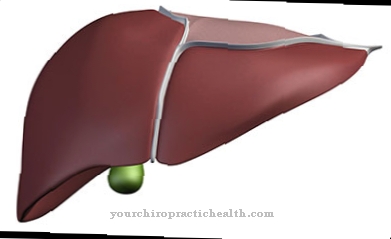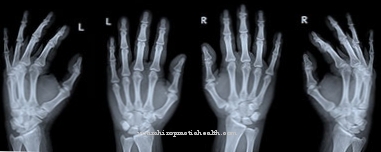At the Fracture of the elbow or Elbow fracture the elbow breaks at the top of the ulna where the triceps tendon attaches. One form of the elbow fracture is that Olecranon fracture. The cause is usually trauma, and treatment is usually performed surgically if the prognosis is good.
What is a broken elbow?

In the case of an olecranon fracture, there is a fracture of the olecranon, the elbow-side end of the ulna. This is also where the elbow joint is located, which is composed of the two forearm bones, the radius and ulna, and the lower part of the humerus. The tendon of the triceps muscle transfers the strength of the arm extensor muscles to the olecranon.
Symptoms of the fracture of the elbow appear immediately after the trauma that caused it and include severe pain, a bruise with severe swelling of the entire joint, and the blue discoloration of the skin around the bruise. Independent movement of the elbow is impossible for the affected person. In some cases, the broken or fractured piece of bone can be felt as it is pulled up through the triceps tendon.
causes
The cause of an elbow fracture is usually a direct trauma, i.e. a fall backwards or to the side that is caught with the elbow or an extended arm.
If too strong a force acts on the weakest point, the elbow joint, it breaks. Mechanically, it can be said that the force of the impact takes hold at the point of least resistance and breaks the joint.
Sometimes the trigger is not a fall, but a hard hit on the elbow joint with a hard object. More rarely, an elbow fracture occurs with previously damaged bone tissue through pathological fractures and as a spontaneous fracture.
Other causes can be increased stress, resulting in a joint fracture due to fatigue. Patients with vitreous bone disease, osteoporosis, bone tumors and metastases are particularly at risk.
Symptoms, ailments & signs
The broken elbow is an extremely painful disease that is usually triggered by an external event, such as a violent fall on the elbow. Immediately after this event, there is very severe pain. A doctor should be consulted for an unequivocal diagnosis of the fracture and subsequent treatment.
The fracture of the elbow results in an almost complete loss of motion of the arm in the elbow joint. The arm can no longer be bent or angled; the attempt causes severe pain. At the same time, the joint swells very quickly, and hematomas can also form.
If a broken elbow is left untreated, this can lead to complete irreversible stiffening of the arm and a variety of orthopedic problems. Professional therapy is therefore absolutely essential. A break in the elbow is very often what is known as an open break. The skin over the joint and bones is very thin and can easily be pierced by a sharp, splintered or broken bone.
In such cases, the bone protrudes visibly from the open wound and the break can also be diagnosed unequivocally by the layperson. In addition, moderate blood loss can occur. The fracture of the elbow is a painful disease even during the healing process and requires extensive physiotherapeutic rehabilitation measures and lengthy exercises.
Diagnosis & course
If severe pain that restricts movement, a bruise and swelling of the elbow joint occur after a fall, the patient should consult a doctor immediately. After a detailed anamnesis, he will examine the elbow joint. This is followed by an X-ray. With this and possibly other examinations, accompanying injuries to blood vessels, ligaments, tendons and nerves should be excluded.
A quick medical treatment is crucial for the success of the treatment, because the strong pull of the triceps muscle shifts the fragments against each other, so that the deviation becomes stronger over time, more difficult to operate and the risk of long-term effects and permanent damage increases.
The prognosis is generally good after an olecranon fracture, and complications are rare. However, there is often a reduced resilience to heavier loads such as tennis, rowing or golf.
More complex fractures with several fragments can lead to irregularities in the joint, premature joint wear and limited joint mobility, despite early treatment.
Complications
If a broken elbow is treated immediately, there are usually no major complications. However, long-term consequences cannot be completely ruled out. After an operation, the resilience of the affected bones and muscles is reduced. Long-term restrictions can arise, especially in sports such as golf, rowing or tennis.
As a result of a debris fracture, for example, irregularities can occur in the joint. This can result in joint wear years later, which is associated with limited mobility of the elbow. Multiple or postponed fractures can also lead to joint stiffness and chronic joint instability. Cartilage and joint degeneration can lead to chronic inflammation and severe pain.
As the disease progresses, osteoarthritis or pseudoarthrosis can occur. Injuries to arteries and nerves cannot be completely ruled out if the elbow breaks. If nerves are injured when the elbow breaks, numbness and sensory disturbances can occur. In most cases, there is also a loss of strength and sensitivity, which can range from the elbow to the little finger. Movement restrictions can also occur, but they usually disappear on their own.
When should you go to the doctor?
If you experience severe pain and restricted mobility in the area of the elbow after an accident or a fall, you may have a broken elbow. A doctor's visit is advisable if the symptoms do not go away on their own and there are further signs of a rupture. If, for example, bruises, swellings and bruises are noticed, this always requires a medical clarification. In the event of further impairments such as circulatory problems or intense pain, the emergency services should be called.
An open fracture must always be examined and treated immediately by a doctor. Depending on the severity of the elbow fracture, the affected person has to spend a few days to weeks in the hospital. In the meantime, the doctor will check carefully whether the tendons, nerves and muscles are growing together properly and, if necessary, order further measures such as physiotherapy or an operation.
After the person has left the hospital, regular check-ups are indicated. Should bleeding, scar pain and other complications occur, this requires a quick clarification by the responsible doctor.
Doctors & therapists in your area
Treatment & Therapy
Until the medical examination, the arm should be splinted, relieved and cooled.
Conservative therapy using immobilization is only possible if the elbow fracture is stable. This means that there must be a maximum of two millimeters between the fragments and that they are not shifted. Immobilization is usually only performed on children. Displaced olecranon fractures require surgery. In the case of comminuted fractures, it is necessary to use a small plate that can be combined with a tension strap.
The tension belt is the most common therapy for an elbow fracture. The fragments are held in the correct position by an assistant while the surgeon sutures the bone with a wire eight-shaped. This operation is usually performed under general anesthesia.
Some fractures can be treated without immobilization after surgery. As a rule, however, a plaster cast is used for about six weeks. During this time, the elbow joint must not be loaded. A few weeks to months after the operation, you may experience discomfort when placing your elbow, which makes it necessary to wear an elbow protector. Physiotherapy helps rebuild the triceps and elbow joints after weeks of immobilization.
Outlook & forecast
An uncomplicated fracture of the elbow is one of the most common broken bones. It usually has a good prognosis because it is one of the routine operations that are very common in hospitals.
It becomes more difficult if the joint was damaged during the break or if the break results in injuries to the soft tissue and blood vessels. If the tissue is no longer adequately supplied with blood, partial areas can die. An elbow fracture also has less favorable prospects if parts of the bone do not grow back together properly. Even with small shifts, there is an incorrect statics, which in the long term leads to incorrect strain on the elbow and promotes joint wear.
Despite the generally good prognosis, it is possible that sports that put a lot of strain on the elbow (such as squash, tennis or golf) can no longer be practiced as they were before the break. Muscle strength and muscle mass were lost due to prolonged immobilization of the arm. In most cases, specific physiotherapeutic exercises are then necessary to strengthen muscle strength again, especially if the patients are older.
prevention
General prevention is difficult because falls tend to happen by chance. Responsible and health-conscious athletes, however, wear well-fitting and risk-minimizing elbow pads that are replaced after each fall.
You can do that yourself
In the event of a broken elbow, the emergency doctor must be notified immediately. Until professional help arrives, the elbow should be protected and, if possible, not moved. A closed fracture can be cooled with an ice pack or cold pack. Open fractures are covered with a sterile wound pad whenever possible. To avoid worsening the fracture, further treatment measures should be carried out by the emergency doctor.
Bone healing can be promoted through exercise and a healthy and balanced diet high in calcium and iron. However, the elbow itself should be spared until the doctor gives his okay to start training again. During the period of rest, gentle massages and saunas are ideal. Both promote blood circulation and thus the healing process.
In consultation with the doctor, alternative treatment methods such as ultrasound therapy or electrotherapy can also be tried. Proven remedies from naturopathy include decongestant arnica, comfrey, which promotes healing, and the Schüßler salts calcium fluoratum and ferrum phosphoricum. Treatment with autologous blood can also promote the healing process, but should always be done under the supervision of a doctor.












.jpg)



.jpg)










.jpg)
